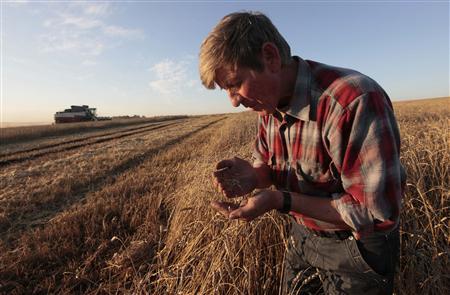(Reuters) – This year’s wheat, piled in steel sheds on the Banner of Lenin collective farm, shimmers greyish-gold in the dusty air, a vision of plenty worthy of a Soviet propaganda poster.

In Soviet times, the 15,000 hectare farm, in Russia’s Black Sea breadbasket region of Krasnodar, would deliver its wheat to the local elevator for shipping inland to make bread.
Since the collapse of the Soviet Union in 1991 the farm has turned itself into a 1 billion rouble ($30.93 million) per year business producing wheat, fruit, sausages and sugar. It sells its 45,000-50,000 million metric tons (55,116 million tons) of high-quality milling wheat at the farm gate to be shipped to consumers such as Turkey.
It is emblematic of a Russian agriculture industry that is trying to establish itself as a force on world markets. With the world’s fourth largest acreage of arable land and few constraints on fresh water supplies, Russia wants to use its natural wealth to spur the economy.
It was Soviet dictator Josef Stalin’s determination to force the peasantry to give up its grain that launched collectivization on these lands nearly 80 years ago, the town’s Bible seized, its church razed and its people left to starve.
State quotas still governed life on the farm when Yuri Kharaman, a wiry man in his late 50s with a permanent sunburn from life in the fields, took over as the collective’s chairman.
“We don’t have that pressure anymore. We can focus on profit per hectare,” said Kharaman, who drives a sport utility vehicle and, like other members of the collective, owns a five-hectare share of the farm’s land near the town of Staroshcherbinovskaya, on the road to the port of Yeisk.
Russia’s farm industry is shaking off the malaise that followed the Soviet collapse. But the country is battling drought as it tries to reclaim its place as a top world exporter, one it held before the 1917 Russian Revolution.
The drought has cut this year’s harvest by nearly 30 percent and led to speculation that Russia could ban exports, as it did in 2010 in a shock to world grain markets.
Soaring prices underline Russia’s importance on world wheat markets, where it was second only to the United States in the 2011/12 crop year. Russia is aiming for grain exports of 40-50 million metric tons by 2020.
For the Banner of Lenin farm, Russia’s re-emergence has brought modest prosperity and money to buy better technology, including John Deere combines to replace older models made in the nearby city of Rostov.
“You had to plough and plough on those,” said Svetlana Dzhagun, who has worked at the farm for 16 years. “Now we have John Deere combines, and you can make good money with them.”
As she speaks, the wheat is long since in and the fields, lined with trees, are all stubble. The farm’s sunflowers are still maturing and a roadside stall sells apples, grapes and watermelons to day trippers headed for the beach. Combine harvesters work the wide, flat fields well into the evening, kicking up dust into the hot air.
STALIN’S COLLECTIVISATION
The potential for growth has not escaped the attention of Russia’s wealthy businessmen or the world’s largest agribusiness companies.
Oleg Deripaska, owner of the world’s largest aluminum company, owns an 84,000 hectare farm in his hometown of Ust-Labinsk north of the regional capital of Krasnodar.
He has fought a public battle with Summa, a port investment group, over the right to buy a stake in Russia’s state grain export infrastructure operator.
“World demand for grain is growing, and exports from Russia will rise on the back of it. Now is the right time to invest in this business,” Summa Group Chief Executive Alexander Vinokurov told Reuters in an interview earlier this year.
“We see the growth of the middle class, an increase in consumption in developing countries. Russia has a large quantity of land, high production upside, and growing demand. There are excellent chances for this growth to continue. It is clear that these are the right conditions for this business.”
Along the North Caucasus Railway, which carries much of Russia’s export grain to the Black Sea port of Novorossiisk, stand Soviet-built grain elevators, now owned by Glencore, Louis Dreyfus, Cargill and Bunge
THE GREAT GRAIN ROBBERY
Russia’s resurgent exports are a consequence not of ambition, but of the collapse that marked the end of the collectivist experiment.
The Soviet Union ceded its position on world wheat markets in the 1970s, when a failed harvest sparked a raid on the world’s grain stores in an audacious trade that became known as the Great Grain Robbery.
That dependence on imports persisted for the better part of 30 years, until the decline of Russia’s meat and dairy industries destroyed domestic demand for feed grain, said one of Russia’s leading agricultural analysts, Andrei Sizov Sr.
“It was really a case of forced selling,” Sizov, founder and chief executive of the SovEcon consultancy, said.
“The early ’90s were years of mass slaughter because there was nothing to feed the livestock, and that spurred exports when Russia had good harvests in 2001 and 2002.”
The late Soviet import addiction had another consequence: Russia met the global commodity boom with its grain storage and transport infrastructure configured for import. Built before the rise of Asia, it now requires billions of dollars in investment to modernize and expand to match Russia’s export ambitions.
Trains dispatched from all over Russia’s farm belt converge on two tunnels through the hills that loom over Novorossiisk, then pass through a jammed rail yard right in the city centre.
“Whatever we do, there will always be only two tunnels,” said Sergei Chebotareff, operations director at Novorossiisk Grain Terminal, where plans are in place to expand capacity by building more lorry bays.
Infrastructure constraints notwithstanding, today collective farms have inherited more than land and collective ownership.
“There is a consumerist attitude that ‘I am doing this for my own benefit and production comes second’. This translates into failure to observe proper agricultural techniques and pilfering,” Sizov said.
“It is a mentality of people who grew up in the Soviet system and it cannot be fixed in a couple of years or even a couple of decades.”
On the darker side of the farm boom, the financial director of a local agricultural enterprise was attacked at the home of a private farmer in the town of Kushchyovskaya and stabbed to death with 10 friends and family members. The town’s name became a byword for lawlessness in the countryside.
Jim Rogers, who with investor and philanthropist George Soros co-founded the group of hedge funds known as the Quantum Fund, thinks a boom in farmland and commodities will see farmers “driving Lamborghinis”. But he is cautious about Russia.
“If you can invest in well-managed countries where there is security of capital you will do very well investing in farmland,” Rogers said in a recent interview in Moscow. “There are people who say Russia is not a safe haven for capital.”
WORKING IN A VACUUM
If farmers are the world’s new rich, the wealth is barely trickling down to Staroshcherbinovskaya, for all the farm town’s modest, self-made prosperity.
The collective’s shareholders receive 720 roubles per month in profits, plus a share of the farm’s output, which has expanded to include fruit, vegetables, flour, sugar and sausage, all produced and marketed under the Banner of Lenin brand.
Average monthly salaries for the 1,100 regular employees are 21,000 roubles, and up to 30,000 ($920) for machinery operators.
Kharaman’s office is a low Soviet brick building which has the farm’s kitchen in it. It sells only food produced on the farm – apricot and cherry pies are today’s seasonal offering. Workers can the farm’s fruit right there in three liter jars.
Export bottlenecks do not worry Kharaman. “The kind of infrastructure we need is roads, kindergartens, social and cultural institutions,” he said.
His greater concern is the changing climate of the south. Drought is more frequent harder to predict, and slashed this year’s wheat yields by 25 percent to 4.5-5 metric tons per hectare.
He thinks farmers in southern Russia should go back to large scale irrigation. But old equipment has decayed, and irrigation channels are in bad shape. In places the reinforced concrete slab lining their walls has plundered for scrap metal.
He is among those who worry that Russia could again ban exports, leaving his farm to sell at depressed domestic prices.
“When wheat costs $300 on the world market, and we get $150, we can’t buy new combines, planters or tractors,” Kharaman said.
The town got its Bible back after Soviet rule collapsed, and the farm financed construction of a chapel to house the remains of a local saint whose grave was discovered during excavations for a World War Two monument in the town centre.
Original plans for the old church were unearthed, and a reconstruction is planned, to be financed partly by donations.
Kharaman says he is not a religious fanatic but hoped the church would serve as a moral guide for his people.
“Before, we had Communist ideology, which had elements of religion,” Kharaman said. “Now there is no ideology at all, and there is a vacuum.” There is not much to remind visitors of Lenin in today’s Banner of Lenin farm, apart from his portrait on the label of the farm’s sausages. ($1 = 31.8535 Russian roubles)
(Editing by Timothy Heritage and Janet McBride)





